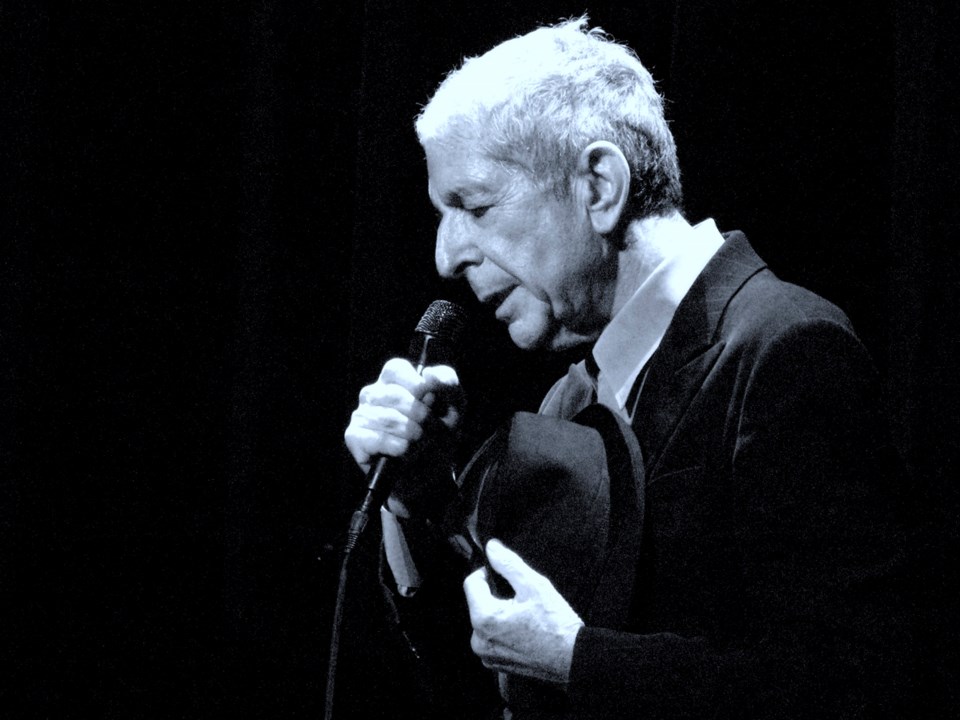Matthew Gindin missed his chance to meet Leonard Cohen. The freelance writer and lecturer, Winnipeg-raised and now a Vancouverite, spent four years as a Buddhist monk in California. Cohen, the legendary Canadian poet and singer who died last month, was also spending time in a Buddhist monastery in California. A mutual acquaintance offered to try to arrange a meet-up, but Gindin said no.
“I was very earnest,” Gindin told me recently. “I was very zealous about what I was doing, and I wasn’t in California to meet rock stars. I'm here to meditate and be a monk.”
But Gindin was and remains a big Cohen fan, taking his interest a little deeper than most, analyzing religious narratives and meanings in Cohen’s work. He will speak at a tribute to Cohen this Sunday (Dec. 11) at the Jewish Community Centre, on 41st near Oak.
Gindin eventually gravitated back to his Jewish roots and it was then that he began noticing the overtly Jewish, and other spiritual, references in Cohen’s work.
“All of a sudden, I began hearing all of these different biblical allusions, biblical narratives, quotations from Jewish scriptures and even kabbalistic and esoteric and mystical stuff that was very subtly woven into his songs, especially his later songs like the ones from the last 10 or 15 years.”
Gindin isn’t the only one to have noticed, of course.
“There has been a collective awakening to what's going on in his writing,” Gindin says. A compendium of academic studies of Cohen’s work is coming out soon. The religious symbolism is largely Jewish, but Cohen also incorporated Christian imagery.
“Cohen is on record saying that Jesus had a big influence on his life,” says Gindin. “I think that Cohen, like a lot of Jews, actually related to Jesus as a Jewish spiritual teacher. Though Cohen, as far as I know, never expressed any interest in institutional Christianity, he was interested in the stories about Jesus and the images and symbols of his life show up frequently in Cohen's songs.”
There is Buddhist content in Cohen's songs as well, he adds, though more so in his poetry.
The song “Hallelujah,” perhaps the Cohen work most widely shared on social media after his passing, encapsulates much about Cohen and his approach to his art.
Brokenness and its potential beauty is a recurring theme for Cohen.
“There is a crack in everything,” he wrote in “Anthem.” “That's how the light gets in.”
Likewise, in “Hallelujah,” Gindin believes Cohen was attempting to “embrace the challenge of clearly seeing God's holy broken world and trying to have the heart to praise it.”
The song embodies several of Cohen’s favourite tricks. He melds the story of Samson and Delilah with that of King David and Bathsheba.
He also combines sexuality and sacredness.
“Throughout the whole song, he goes back and forth between images of male-female romance and images of human-divine interaction, which is a typical move for him,” Gindin says. “You can't understand a lot of his songs unless you understand that he writes them intentionally to be ambiguous about whether he's talking about sex or whether he's talking about spiritual union.”
“And from your lips she drew ‘hallelujah,’” the song goes.
“Obviously a reference to orgasm,” says Gindin. “He’s just being a little bit scandalous.” That's when Cohen turns to address the audience and says, “You say I took the name in vain/I don't even know the name/But if I did, well really, what's it to you?”
“He's sort of mocking the sanctimoniousness of his imagined audience,” Gindin says. “He's defending his characteristic move as a writer, which is to use the sacred and the profane and to find holiness in the broken.”
In the title song of Cohen’s final album, You Want It Darker, Cohen uses Jewish messaging to signal, perhaps, his imminent death.
“In that song, Cohen is talking to God and struggling with him because he's basically saying to God, ultimately, you have responsibility and you have a role in the darkness that's coming on the world right now,” Gindin says. “There is a sort of anger and a struggling with God, which also occurs in other of his songs and more generally in the Jewish tradition.”
During the chorus, Cohen repeatedly incants “Hineni, Hineni.”
Meaning “I am here,” these are the words that many Jewish prophets said to God when God calls them. Then Cohen says, “I’m ready, my lord.”
“The song combines this ongoing struggle with God, but ultimately affirms his connection to God and his readiness to meet God.”
In the same song, Cohen sings, “Magnified, sanctified, be thy holy name/Vilified, crucified, in the human frame.” Here Cohen slides seamlessly from Jewish to Christian imagery.
The first line is an English translation of the Kaddish, a Jewish prayer that is said for the dead.
In the second line, Gindin says, “anyone who is at all familiar with Christianity immediately knows that ‘vilified, crucified in the human frame’ is a reference to God being vilified and crucified in the incarnation of Jesus's body.”
The event Sunday at 5 p.m. marks shloshim, the 30th day since Cohen’s burial, and the end of a 30-day mourning period. When the Jewish Community Centre asked Gindin if he would lecture about Jewish imagery in Cohen’s work, Gindin replied, “Hineni.” Also on the bill is Ira Nadel, a UBC English professor and author of two books on Cohen, as well as poetry reading and music. Artwork by Cohen will also be on display in the centre’s Zack Gallery.
“It's an opportunity to come together with a community of people who loved Leonard Cohen and to commemorate his life,” Gindin says. “It's an opportunity to take part in a communal, and you might even say ritual, commemoration of his life.”



